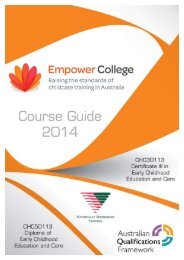Anaphylaxis Management Guidelines
You also want an ePaper? Increase the reach of your titles
YUMPU automatically turns print PDFs into web optimized ePapers that Google loves.
Appendix 1<br />
Sample <strong>Anaphylaxis</strong> <strong>Management</strong> Policy<br />
for Child Care Services<br />
Note: this is a sample policy and has been developed to be used in conjunction with the <strong>Anaphylaxis</strong><br />
<strong>Management</strong> <strong>Guidelines</strong> for Child Care and Outside School Hours Care Services in Western Australia<br />
document. Your service may choose to develop or update your own anaphylaxis management policy.<br />
Considerations:<br />
Philosophy:<br />
Legislation:<br />
Children’s needs:<br />
Parent’s needs:<br />
Staff needs:<br />
Protection of children in the service; inclusiveness/non-discrimination;<br />
educating parents; raising community awareness.<br />
Duty of Care requirements; Equal Opportunity — Anti-discrimination; Privacy<br />
Act 1988; Child Care Services Act 2007 and relevant regulations (WA);<br />
Poisons Act 1964; Poisons Regulations 1965;<br />
To be accepted as normal – not singled out as different; to feel safe: to be<br />
protected from their allergens.<br />
To reduce their anxiety and feel confident that their child is safe; to feel that<br />
their concerns are taken seriously.<br />
Training; clear action plans to follow; opportunities to practise and refresh<br />
knowledge; to reduce their anxiety in dealing with an anaphylactic response;<br />
to debrief after an incident; sufficient notice of the introduction of new policy.<br />
<strong>Management</strong> needs: That parents/guardians understand the serious nature of some allergies<br />
and how they can assist the service to avoid allergens; to be informed and<br />
educated in regard to anaphylaxis; appropriate policies are written, adhered<br />
to and regularly updated; staff are prepared to act in emergency situations;<br />
Action Plans are prepared with input from a child’s medical practitioner and<br />
parent/guardian, and endorsed by both.<br />
Background<br />
<strong>Anaphylaxis</strong> is a severe, rapidly progressive allergic reaction that is potentially life threatening.<br />
The prevalence of allergies is increasing with approximately 1 in 20 Australian children having food<br />
allergy and approximately 1 in 50 having peanut allergy.<br />
The most common allergens in children are:<br />
peanuts cow’s milk soy<br />
eggs fish and shellfish sesame<br />
tree nuts (e.g. cashews) wheat certain insect venoms<br />
(particularly bee stings)<br />
The key to the prevention of anaphylaxis in child care services is knowledge of those children who<br />
have been diagnosed as at risk, awareness of allergens, and prevention of exposure to those<br />
allergens. Communication between child care services and parents/guardians is important in helping<br />
children avoid exposure.<br />
Adrenaline given through an adrenaline autoinjector (such as an EpiPen ® or Anapen ® ) into the<br />
muscle of the outer mid thigh is the most effective first aid treatment for anaphylaxis.<br />
26 <strong>Anaphylaxis</strong> <strong>Management</strong> <strong>Guidelines</strong>





